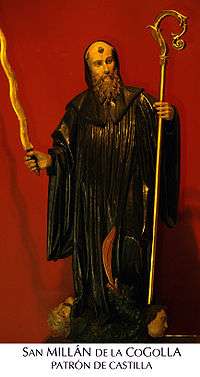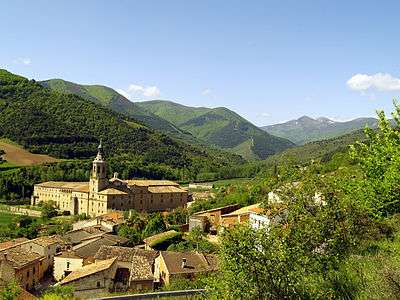Emilian of Cogolla
Saint Aemilian (in Latin Emilianus or Aemilianus) (12 November 472 – 11 June 573) is an Iberic saint, widely revered throughout Spain, who lived during the age of Visigothic rule.
Emilianus | |
|---|---|
 | |
| Abbot | |
| Born | 12 November 472 La Rioja, Spain |
| Died | 11 June 573 Spain |
| Venerated in | Roman Catholic Church Eastern Orthodox Church Anglican Communion |
| Major shrine | Augustinian Recollets monastery of La Cogolla |
| Feast | 12 November |
| Attributes | monk on horseback |
| Patronage | Castile |

Life
According to his Vita, written by Braulius, bishop of Caesaraugusta (modern Zaragoza) roughly a hundred years after the saint's death, Emilianus was born in Vergaja,[1] which is identified with Berceo in La Rioja, where he was a shepherd.
Emilian had a religious experience, perhaps around the age of twenty, which led him to decide to dedicate himself to God's service. He sought out an experienced hermit in Bilibio,[2] Felix (more usually known by the Spanish form of his common name, San Felices), where Emilianus lived for a number of years.
After leaving his teacher, Emilianus lived as a hermit (perhaps even a gyrovagus) in the mountains or on the historic Roman road which became the Camino de Santiago. Didymus the Bishop of Tarazona ordained Emilianus and appointed him parish priest of Vergaja. However, Emilianus aroused the opposition of his fellow priests because of his heavy distribution of alms or reputation for holiness or miracleworking. Emilianus returned to the wilderness, and a small community of disciples gathered around his cell. He died at a venerable age, and his body, was initially interred at his hermitage, but later transferred to a monastery built in memory of him.
Veneration
Braulius also recorded miracles that occurred after Aemilian's death, but the fame of the San Millán de la Cogolla monastery dedicated in his memory (and which held his tomb) eclipsed that of its founder. San Millán de Suso monastery is known for its Mozarabic architecture, and its growing popularity during the heyday of the pilgrimage rout led to its expansion in the eleventh century with San Millán de Yuso (the communities however having separate abbots until the 12th century).
The longstanding monastic community (Benedictine by the mid-medieval era) is credited with one of the oldest books written in the Spanish language, the Vida de San Millán de la Cogolla (biography by Gonzalo de Berceo). St. Dominic of Silos (the miracleworker for whom Saint Dominic was named) also received his education and began his religious career at San Millan monastery.
He is a patron saint of La Rioja; the longer name of San Millán de la Cogolla refers to the monastic cowl. Because of the monastery's role on the traditional pilgrimage route, representations of Emilianus can be mixed with that of Saint James the Moor-slayer, such as a Benedictine on horseback with a banner and sword.
See also
- San Millán de la Cogolla, La Rioja
- es:Monasterio de San Millán de Yuso
- es:Monasterio de San Millán de Suso7
References
- Monks of Ramsgate. "Aemilian". Book of Saints, 1921 CatholicSaints.Info. 26 November 2016

- "Bilibio, también conocido como Haro la Vieja, fue una aldea situada en la falda norte de los Riscos de Bilibio, donde el río Ebro entra en La Rioja por el lugar de Las Conchas, municipio de Haro." (Paloma Torrijos, "Historia y Genealogìa")